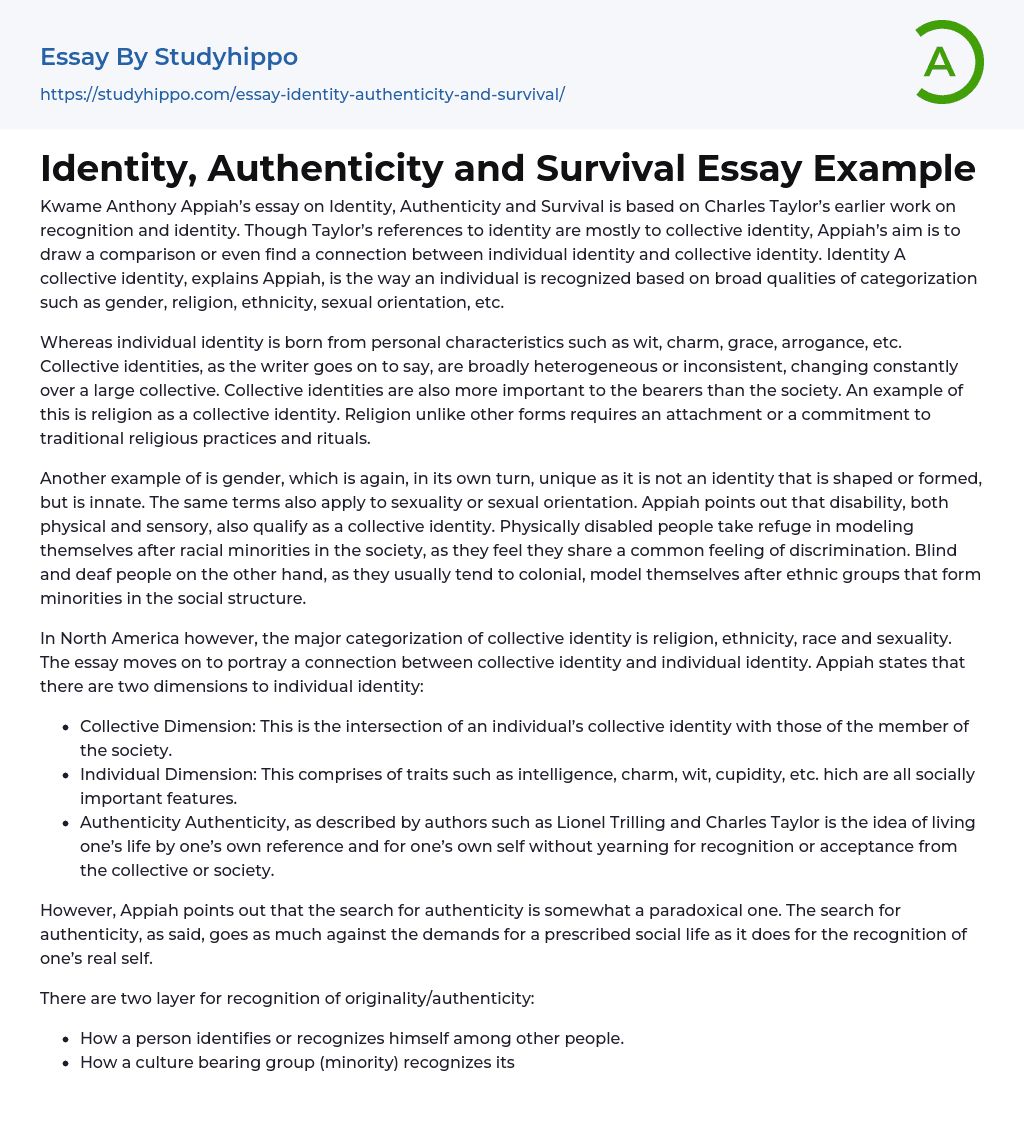Kwame Anthony Appiah’s essay on Identity, Authenticity and Survival is based on Charles Taylor’s earlier work on recognition and identity. Though Taylor’s references to identity are mostly to collective identity, Appiah’s aim is to draw a comparison or even find a connection between individual identity and collective identity. Identity A collective identity, explains Appiah, is the way an individual is recognized based on broad qualities of categorization such as gender, religion, ethnicity, sexual orientation, etc.
Whereas individual identity is born from personal characteristics such as wit, charm, grace, arrogance, etc. Collective identities, as the writer goes on to say, are broadly heterogeneous or inconsistent, changing constantly over a large collective. Collective identities are also more important to the bearers than the society. An example of this is religion as a collective identity. Religi
...on unlike other forms requires an attachment or a commitment to traditional religious practices and rituals.
Another example of is gender, which is again, in its own turn, unique as it is not an identity that is shaped or formed, but is innate. The same terms also apply to sexuality or sexual orientation. Appiah points out that disability, both physical and sensory, also qualify as a collective identity. Physically disabled people take refuge in modeling themselves after racial minorities in the society, as they feel they share a common feeling of discrimination. Blind and deaf people on the other hand, as they usually tend to colonial, model themselves after ethnic groups that form minorities in the social structure.
In North America however, the major categorization of collective identity is religion, ethnicity, race and sexuality. The essay moves on to portray a connection between collective identity an
individual identity. Appiah states that there are two dimensions to individual identity:
- Collective Dimension: This is the intersection of an individual’s collective identity with those of the member of the society.
- Individual Dimension: This comprises of traits such as intelligence, charm, wit, cupidity, etc. hich are all socially important features.
- Authenticity Authenticity, as described by authors such as Lionel Trilling and Charles Taylor is the idea of living one’s life by one’s own reference and for one’s own self without yearning for recognition or acceptance from the collective or society.
However, Appiah points out that the search for authenticity is somewhat a paradoxical one. The search for authenticity, as said, goes as much against the demands for a prescribed social life as it does for the recognition of one’s real self.
There are two layer for recognition of originality/authenticity:
- How a person identifies or recognizes himself among other people.
- How a culture bearing group (minority) recognizes itself among a larger group. This leg of Appiah’s essay focuses extensively on Trilling’s contradictory statements on authenticity.
Claiming one’s authentic ethnicity, for example, for the need of expressing one’s originality in turn proves one’s need for social acknowledgement for such originality.
Even counterconventionalism requires needs recognition from conventionalist. The problem that arises here is, in order to be original, an individual has to understand convention and being everything that it is not, thus resulting in the individual being not authentic, but antagonistic. Also, from another point of view proving the paradox of authenticity, a person not only comes to understand who he is by what people think of him, but his actual identity , infact is generated by the forces that shaped
him such as educational systems, social politics, etc.
Appiah’s only limitation in this work is his need to focus mostly on his ethnicity, as he only cites examples pertinent to African-Americans. This somewhat narrow the focal aperture for his claims on collective identities of minority groups being shaped by the majority amidst whom they find themselves. He does not talk about immigration or intermixing of collective identities, but the antagonistic manifestation of a fresh identity that ‘his’ people had achieved, wherein, a black man’s habitual characteristic would have to be opposing in every way to a white man’s.
In conclusion, Anthony Appiah believes that the real self is not something that can be dug up from the deepest reaches of one’s self, but something that an individual creates, all the while sticking to guidelines and choosing from options provided by the society. He believes that though society cannot set rigid prescriptions as to how a person of a collective identity should behave, it offers stereotypical modes of behavior that are acceptable. This is, as he rightly claims, helps one shape a life story befitting to his collective identity, so that it could fit into the larger collective life story of one’s immediate society.
- Social Construction of Gender essays
- Cultural Identity essays
- Boy essays
- Gay essays
- Gender essays
- Gender Identity essays
- Gender Roles In Society essays
- Gender Stereotypes essays
- Girl essays
- Homosexuality essays
- Human Sexual Behavior essays
- Lgbt essays
- Man essays
- Masculinity essays
- Sexual Orientation essays
- Transgender essays
- Woman essays
- African American essays
- African American Culture essays
- American Values essays
- Asian American essays
- Chinese essays
- Ethnicity essays
- Ethnocentrism essays
- German essays
- Han Chinese essays
- Hispanic essays
- Identity essays
- Korean essays
- Mexican essays
- Nation essays
- Native American essays
- Race and Ethnicity essays
- White People essays
- Caste System essays
- Citizenship essays
- Civil Society essays
- Community essays
- Culture essays
- Deviance essays
- Discourse Community essays
- Female essays
- Filipino People essays
- Igbo People essays
- Indigenous Australians essays
- Indigenous Peoples essays
- Men essays
- Middle Class essays
- Minority Group essays
- Modern Society essays




